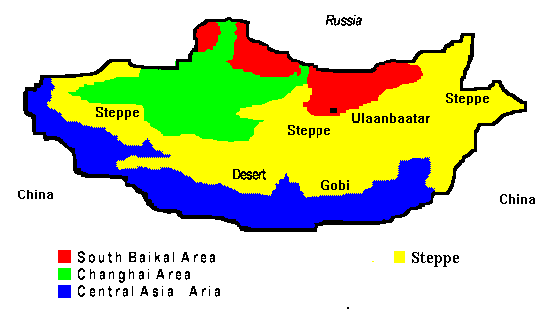
The whole area of Mongolia amounts to 155 mill. ha. 13,7 mill ha is covered with forest, mostly first overgrown with trees and shrubs - that are 8,8 % of the whole country. There are three different forest ecosystems:
1.) The South Baikal Area:
It is a pine taiga - forest; in the north, directly on the border to Russia with these kinds of trees: pine (Pinus sibirica), pine (Pinus silvestis), spruce (Picea obovata), larch (Larix sibirica), fir (Abies sibirica) and birch (Betula platyphylla)
2.) The Changai -Area:
Is a larch - taiga - forest, in the west of Mongolia, with only two tree species: larch (Larix sibirica) and birch (Betula platyphylla)
Both areas are together amount to 10,7 Mill. ha, that are 6,4 % of Mongolia. The average growing stock is 104 cubic metre per ha. Only in a smal area, where people are living, 800.000 cubic metres of trees are cut a year. Sustainable forest management is unknown. The growth amounts to 3,75 mill cubic metres a year. That is more than the nation al demand. In the communism time the anmal cut was more than 2,000 000 cubic metres per year as clear cut. Remember: in Mongolia the natural vegetaiton varies from forest over steppe to desert. In the forest areas the succession starts first with the pionier birch. The Mongolians have religion problems to use the timber from this tree. In the figthing areas between forest and steppe often steppe wins. Nowadays man made fire and following insect attacks brought a lot of problems to the forest areas.
The tree species distribution:
larch 71% the most importent tree, lumber
pine 11% gather nuts, tree cut is forbidden by law
birch 10% pionier after clear cut, admixed tree
pine 7% furniture,lumber
poplar 1% tree at the river banks
3.) The Central Asia Area:
Is partly covered by shrub in the mountains and desert region in the south-west of Mongolia, the most importent shrub is the Saxaul (Holoxylon ammodendron). This area covers 3 mill ha, the most importent protection against the wind under extrem climate for wildlife, livestock and people.
Autor: Manfred Vesper
